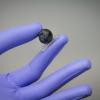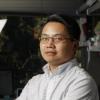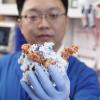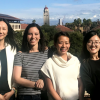Chemistry, Engineering & Medicine for Human Health
News and Press Releases
Dec 10 2018 | Stanford Engineering
The new technique repurposes a common tool in biology that can help separate red blood cells from white blood cells or human cells from microbial cells.
Dec 6 2018 | Stanford Medicine
To treat diabetes directly, rather than manage its symptoms, doctors need a way to get drugs to cells that produce insulin. The key, Stanford researchers report, may be those cells’ affinity for zinc.
Dec 5 2018 | Stanford Medicine
A lowly sea creature may provide a way to understand our own blood-forming system, improve our immune function and find new immune-associated tools for biological discovery, Stanford researchers say.
Dec 4 2018 | Stanford ChEM-H
ChEM-H Institute Scholar Lingyin Li answers some questions about what brought her to ChEM-H, who her role models were growing up, and why she is so fascinated by the innate immune system, a “chemist’s playground.”
Dec 4 2018 | SCOPE by Stanford Medicine
In a recent paper published in ACS Central Science, ChEM-H CBI trainee Elizabeth Webster, a graduate student in the lab of ChEM-H faculty fellow Steve Boxer, gets closer to understanding how the Zika virus infects cells.
Nov 28 2018 | Stanford News
A new discovery reveals how cells decide what to do with misshapen proteins – whether to salvage or destroy them – and could guide research into neurodegenerative diseases and other cellular processes.
Nov 21 2018 | Stanford News
Stanford researchers have developed an electronic glove that bestows robotic hands with some of the manual dexterity humans enjoy.
Nov 21 2018 | SCOPE by Stanford Medicine
ChEM-H faculty fellow Zhenan Bao and her team developed a robotic hand with some human-like dexterity for handling delicate objects.
Nov 15 2018 | Stanford Medicine
Researchers at Stanford and several other institutions have linked the gut ecosystems of four Himalayan groups to the extent of each group’s departure from a hunter-gatherer lifestyle.
Nov 14 2018 | Stanford Medicine
The Stanford project, led by neuroscientists Tony Wyss-Coray and Marion Buckwalter, will focus on the influence of immune factors and systemic inflammation on the brain.
Nov 5 2018 | Stanford News
Chemists have modified a common antibiotic to make it more effective at fighting off one common type of antibiotic-resistant bacterium, known as MRSA.
Nov 4 2018 | Stanford Medicine
Three individuals will be awarded the Dean’s Medal for their contributions to the mission of Stanford Medicine.
Oct 31 2018 | Stanford News
Minuscule nanostraws could help solve the problem of how to deliver precise doses of molecules directly into many cells at once.
Oct 25 2018 | Stanford Chemistry
ChEM-H Baker Family Co-Director Carolyn Bertozzi and ChEM-H Institute Scholar Laura Dassama discuss the intersection of science and social media. Keep up with Stanford ChEM-H on Twitter: @Stanford_ChEMH.
Oct 25 2018 | Stanford Medicine
Understanding when and where proteins bind to DNA may be the ticket to identifying cancer at the cellular level, according to researchers at Stanford.
Oct 24 2018 | Stanford Engineering
Spatial organization in the nucleus of a cell governs cell function. Knowing this, researchers explore how moving genetic material from one area to another could impact health.
Oct 15 2018 | Stanford Medicine
A computational tool designed by ChEM-H Faculty Fellow Ami Bhatt and colleagues makes it easier to identify the source of bloodstream infections and, ideally, rid patients of reservoirs where potentially troublesome microbes reside.
Oct 15 2018 | Stanford News
Watching the movement of every cell in an adult animal all at once, the Prakash lab discovered ultra-fast cellular contractions. This research suggests a new role for cellular contractions in tissue cohesion, which could be the basis of a new material.
Oct 11 2018 | Stanford ChEM-H
Faculty fellow Zhenan Bao and researchers in her group have created a stretchable, conductive material that could be used to integrate electronics with squishy biological tissue.
Oct 11 2018 | Stanford Medicine
Using a new variation of gene-editing technology CRISPR, Stanford ChEM-H Institute Scholar Stanley Qi and colleagues were able to change the spatial organization of DNA in cell nuclei and show how physical relocation altered cell function.























